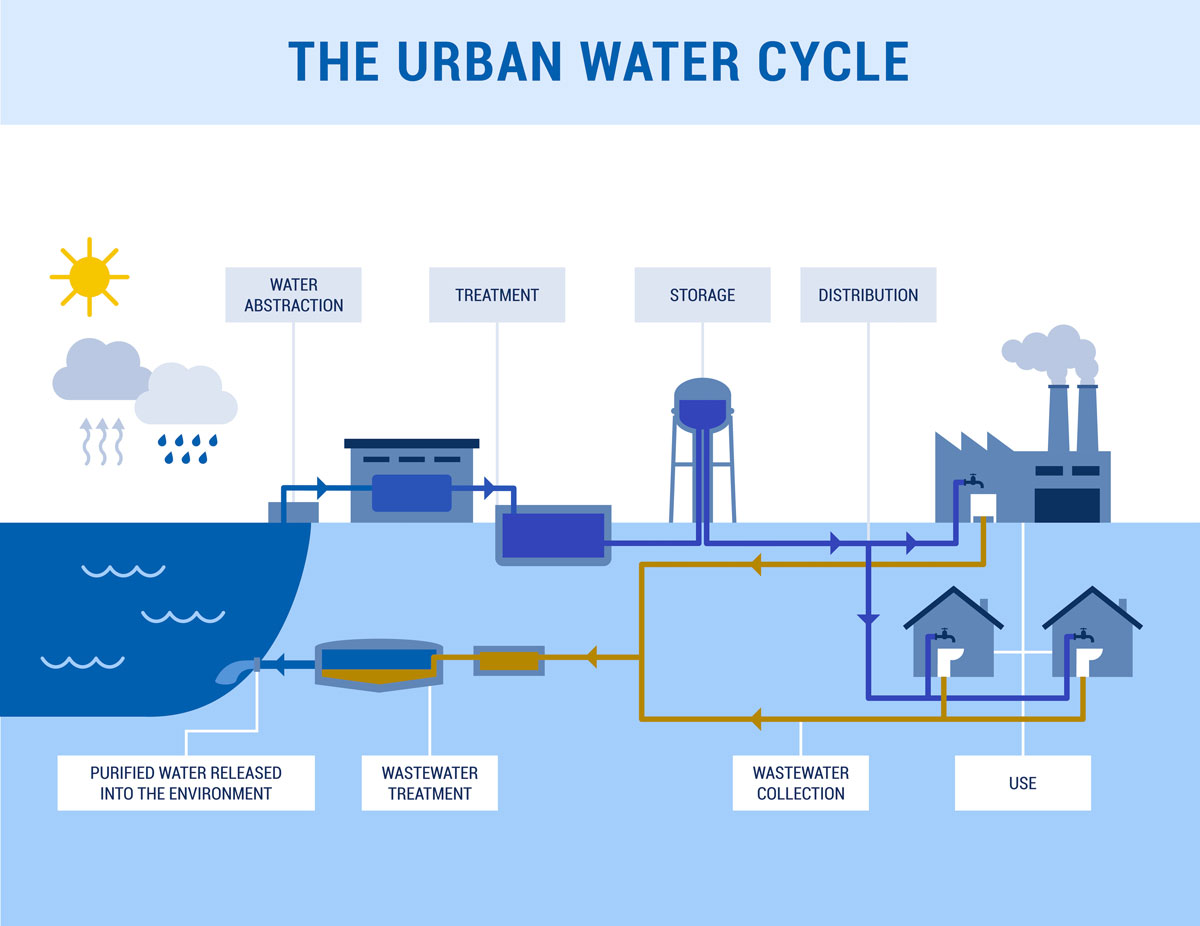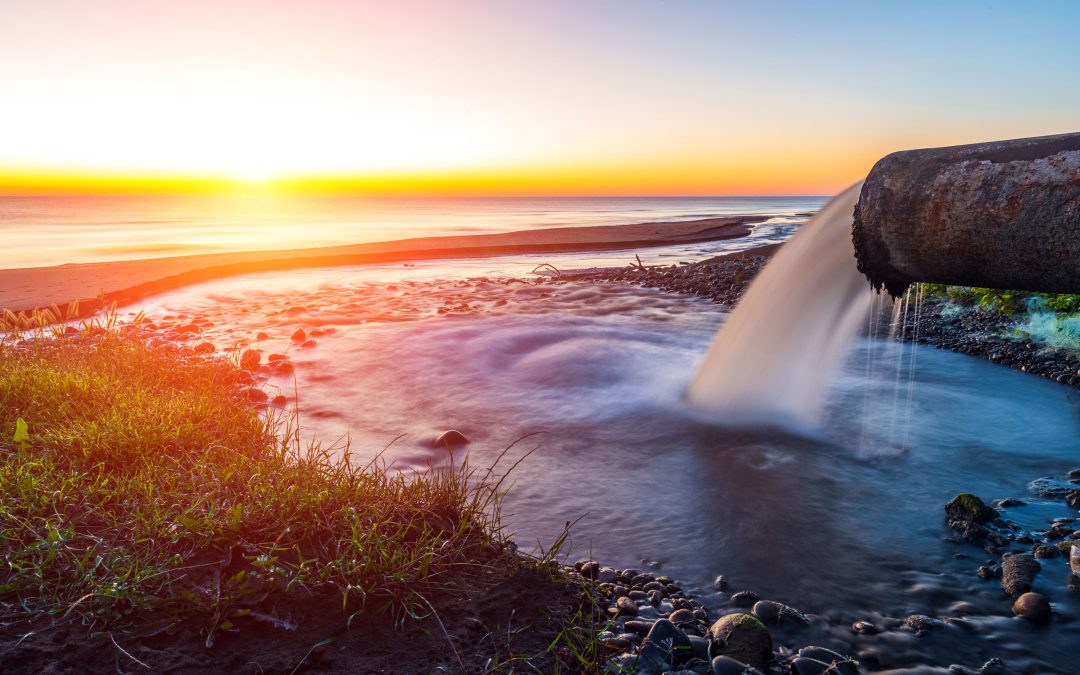Following recent heavy rain, it has been reported that UK water companies have been compelled to discharge raw sewerage into our rivers and seas. News reports talk of the inconvenience and possible health hazards for humans wishing to swim. But of course, these events potentially have an even greater consequence for aquatic flora and fauna and for wildlife. So why does sewage get discharged into waterways and how could green roofing help protect our water cycle from sewage spills?
How Human Activity Affects The Natural Water Cycle
Millions of years ago, probably before human even existed, Mother Nature evolved a very simple and beautiful water cycle.

The warmth of the sun evaporates water from seas, waterways, vegetation and the topmost layer of the soil…. It’s a brilliant way of cooling surfaces and plants.
That water vapour rises, and as it does so it cools and condensed to become water droplets. The droplets fall as rain, are absorbed by the earth’s surface and filter through layers of soil and bedrock to find their way back into waterways. A cycle within the cycle sees water sustaining life as it passes through plants and animals.

Human activity – especially in urban areas interrupts and disrupts the natural water cycle. By building roads, car parks, homes, retail parks, warehousing etc, we effectively seal the surface of the soil. This means that rainwater can no longer be easily absorbed by the earth, in fact it becomes a nuisance to us. We prefer our surfaces to be firm and dry rather than boggy or flooded, and so we divert the water elsewhere.
And then, as well as drinking that lovely fresh water, we add chemicals to it and use it for manufacturing, cleaning and goodness knows what else.
Because runoff from hard surfaces and waste water from homes and workplaces is generally contaminated. We capture and treat it before releasing it back into the environment. Which, is great when the system functions efficiently.
However, in the aftermath of heavy rainfall, the network of drains, pipes and treatment works can become overwhelmed. And that’s when untreated water gets released into rivers and seas where it has the potential to cause untold, and irreversible damage.
How Does Green Roofing Affect The Water Cycle?
There are umpteen benefits to green roofing, one of which is the effect it has on rainfall. Roofs exist to keep us, and the things we need, dry. Therefore it follows that standard roofs are impermeable surfaces, designed to repel water and send it gushing away from the building and into our complex drainage systems. Green roofs are different. They are waterproof but they are also capable of retaining water. Sounds like a contradiction in terms? It’s not.
A living green roof is effectively a layer of vegetation and growing medium installed on top of a waterproof membrane. So rainwater can soak into the green roof buildup but not penetrate the building. So with a green roof, you get the best of both worlds. Something that emulates nature and something to keep you dry.
The only slight disadvantage of a living roof is that it is not directly connected to the ground and so excess water cannot filter through to the bedrock as it does in nature. But, it does at least go some way to bridging the gap between the natural and urban water cycles.
What a living roof does, is retain a good proportion of the rainwater that falls upon it and then releases it gradually. Partly into the atmosphere as evapotranspiration from the plants upon it, and partly into drainage systems or SUDs – depending on the design on the building.
This mechanism helps to ensure that drainage systems are less likely to be overwhelmed by a sudden influx of rainwater. In turn, this reduces the need to discharge raw sewage into waterways.
This living green roof is capable of retaining up to 80% of stormwater that falls upon it, thus releasing pressure on drainage systems
How Much Rain Water Is Retained By Green Roofs?
Scientists have carried out a lot of research into the effect of green roofs on stormwater runoff. And they’ve generated far too much information to squeeze into one blog post. So I’ve attached a link to a relevant report at the end of this article. Feel free to download them and read it at your leisure.
The amount of rainwater retained by a green roof depends on several factors – nothing is simple where Mother Nature is concerned!
- The depth of the growing medium (also known as substrate)
- The vegetation cover
- Whether or not the roof also adopts blue/green technology
- How saturated the substrate layer is at the beginning of the rainfall event
- The intensity of the rainfall
- The time of year
Despite all of those variants – and remember the only things that we as humans can control are the depth of substrate, the use of blue-green technology and the type and health of the vegetation – there is strong evidence to show that green roofs not only retain a lot more water than standard roofs, they delay the release of that water so that it is less likely to overwhelm drainage systems.

A beautiful illustration of how effective green roofs can be at retaining rainfall. Source: www.elsevier.com/locate/landurbplan
In summary
If we don’t want to find ourselves swimming in contaminated water or losing precious biodiversity because the chemical composition of our waterways has changed, then we need to eliminate the need to discharge raw sewage from out treatment works.
In an ideal world, we would be able to create and maintain more green spaces so that rainwater can enter into the natural water cycle. However, that would mean drastic (and expensive) changes to our infrastructure. Realistically, that’s not going to happen.
Green roofing and blue-green roofing technology offers an opportunity to at least partly emulate the natural water cycle by taking advantage of the unused space on top of our buildings. What’s not to like?
Discover more about green roofs, blue roofs and rainwater attenuation here
Read “Green roofs as a tool for solving the rainwater runoff problem in the urbanized 21st century?”


